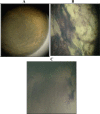Putative free radical-scavenging activity of an extract of Cineraria maritima in preventing selenite-induced cataractogenesis in Wistar rat pups
- PMID: 24357923
- PMCID: PMC3867162
Putative free radical-scavenging activity of an extract of Cineraria maritima in preventing selenite-induced cataractogenesis in Wistar rat pups
Abstract
Purpose: To investigate the possible free radical-scavenging activity of an extract of Cineraria maritima on selenite-induced cataractous lenses in Wistar rat pups.
Methods: In the present study, Wistar rat pups were divided into three experimental groups. On P10, Group I (control) rat pups received an intraperitoneal injection of 0.89% saline. Rats in groups II (selenite-challenged, untreated) and III (selenite-challenged, C. maritima treated) received a subcutaneous injection of sodium selenite (19 μmol/kg bodyweight); Group III rat pups also received an intraperitoneal injection of the extract of C. maritima (350 mg/kg bodyweight) once daily P9-14. Both eyes of each pup were examined from P16 until P30. Cytochemical localization of nitroblue tetrazolium salts and generation of superoxide, hydroxyl, and nitric oxide levels were measured. The expression of the inducible nitric oxide synthase gene was evaluated with reverse transcription-PCR. Immunoblot analysis was also performed to confirm the differential expression of the inducible nitric oxide synthase protein.
Results: Subcutaneous injection of sodium selenite led to severe oxidative damage in the lenticular tissues, shown by increased formation of formazan crystals, elevated generation of superoxide, hydroxyl, and nitric oxide radicals, and elevated inducible nitric oxide synthase gene and protein expression that possibly contributed to the opacification of the lens and thus cataract formation. When rat pups were treated with intraperitoneal administration of the extract of C. maritima, the generation of free radicals as well as the messenger ribonucleic acid and protein expression of inducible nitric oxide synthase were maintained at near normal levels.
Conclusions: The data generated by this study suggest that an ethanolic extract of C. maritima possibly prevents cataractogenesis in a rat model by minimizing free radical generation.
Figures






Similar articles
-
Prevention of selenite-induced cataractogenesis by an ethanolic extract of Cineraria maritima: an experimental evaluation of the traditional eye medication.Biol Trace Elem Res. 2011 Oct;143(1):425-36. doi: 10.1007/s12011-010-8876-x. Epub 2010 Oct 15. Biol Trace Elem Res. 2011. PMID: 20949376
-
Anti-cataractogenic effect of curcumin and aminoguanidine against selenium-induced oxidative stress in the eye lens of Wistar rat pups: An in vitro study using isolated lens.Chem Biol Interact. 2009 Oct 7;181(2):202-9. doi: 10.1016/j.cbi.2009.05.011. Epub 2009 May 27. Chem Biol Interact. 2009. PMID: 19481068
-
Prevention of Selenite-Induced Cataratogenesis by Ginkgo biloba Extract (Egb761) in Wistar Rats.Curr Eye Res. 2015;40(10):1028-33. doi: 10.3109/02713683.2014.980005. Epub 2014 Nov 7. Curr Eye Res. 2015. PMID: 25380229
-
Transcriptional regulation of crystallin, redox, and apoptotic genes by C-Phycocyanin in the selenite-induced cataractogenic rat model.Mol Vis. 2015 Jan 14;21:26-39. eCollection 2015. Mol Vis. 2015. PMID: 25593511 Free PMC article.
-
The effect of different antioxidants on nitric oxide production in hypertensive rats.Physiol Res. 2006;55 Suppl 1:S3-S16. doi: 10.33549/physiolres.930000.55.S1.3. Physiol Res. 2006. PMID: 17177623 Review.
Cited by
-
Medicinal Plants and Natural Products Used in Cataract Management.Front Pharmacol. 2019 Jun 13;10:466. doi: 10.3389/fphar.2019.00466. eCollection 2019. Front Pharmacol. 2019. PMID: 31263410 Free PMC article. Review.
-
Polyphenol-enriched fraction of Vaccinium uliginosum L. protects selenite-induced cataract formation in the lens of Sprague-Dawley rat pups.Mol Vis. 2019 Feb 8;25:118-128. eCollection 2019. Mol Vis. 2019. PMID: 30820147 Free PMC article.
References
-
- Cornish KM, Williamson G, Sanderson J. Quercetin metabolism in the lens: role in inhibition of hydrogen peroxide induced cataract. Free Radic Biol Med. 2002;33:63–70. - PubMed
-
- Boscia F, Grattagliano I, Vendemiale G, Micelli-Ferrari T, Altomare E. Protein oxidation and lens opacity in humans. Invest Ophthalmol Vis Sci. 2000;41:2461–5. - PubMed
-
- Bhuyan KC, Bhuyan DK. Molecular mechanism of cataractogenesis: III. Toxic metabolites of oxygen as initiators of lipid peroxidation and cataract. Curr Eye Res. 1984;3:67–81. - PubMed
-
- Spector A. Oxidative stress-induced cataract: mechanism of action. FASEB J. 1995;9:1173–82. - PubMed
-
- Fu S, Dean R, Southan M, Truscott R. The hydroxyl radical in lens nuclear cataractogenesis. J Biol Chem. 1998;273:28603–9. - PubMed
Publication types
MeSH terms
Substances
LinkOut - more resources
Full Text Sources
Medical
